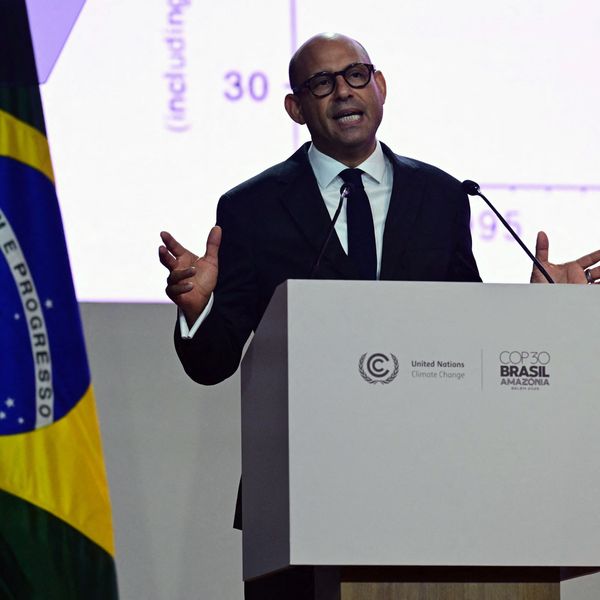Copenhagen: Only the Numbers Count - and They Add up to Hell on Earth
Climate Interactive's software speaks numbers, not spin – which is where the true understanding of the Copenhagen summit lies
The Bella centre is a swirl of chatter, the streets of Copenhagen are a swirl of protest. Depending on what hour you listen to the news bulletin, the UN climate negotiations have "come off the rails" or are "back on track" or have "stalled" or are "moving swiftly". Which is why the only people who really understand what's going on may be a small crew of folks from a group of computer jockeys called Climate Interactive. Their software speaks numbers, not spin - and in the end it's the numbers that count.
First number to know: 350. It's what scientists have been saying for two years is the maximum amount of carbon dioxide we can safely have in the atmosphere, measured in parts per million. Those scientists have been joined by an unprecedented outpouring from civil society: in late October, activists put on what CNN called "the most widespread day of political action in the planet's history," with 5,200 demonstrations in 181 countries, all rallying around that number. Three thousand vigils last weekend across the planet spelled out the number in candles. Thousands of churches rang their bells 350 times on Sunday, and yesterday the World Parliament of Religions, meeting in Melbourne and representing the "largest interreligious gathering on earth" sent an emergency 350 declaration here to Copenhagen.
The second number: 100. That's (roughly) how many countries are backing a 350 target here at Copenhagen. That's more than half the nations in attendance - unfortunately, they're the small, poor ones. But it's amazing to see them, in the face of enormous pressure, keeping the idea of real action alive. Yesterday Mohamed Nasheed, president of the Maldives, spoke to a roaring crowd of thousands: "We know what the laws of physics say: the most important number in the world is 350."
The third number: 4%. That's how much the US is offering to cut its emissions from their 1990 levels by 2020. Scientists tell us that the developed world would need to reduce by at least 40% to get us back on a 350 track, so the American offer is exactly an order or magnitude off. And they're not alone. All the rich countries, not to mention China, are looking to do as little as possible and still escape here with some kind of agreement they can hide behind.
The fourth number - and the most important one. When the folks at Climate Interactive plug in every promise made at these talks (the American offer on the table, the Chinese promise to reduce "energy intensity", the EU pledges, and so on) their software tells them almost instantly how much carbon they would eventually produce. When they hit the button last night, the program showed that by 2100 the world's CO2 concentrations (currently 390) would be - drumroll please - 770. That is, we would live in hell, or at least a place with a similar temperature.
So that's the scorecard. You may hear a lot of happy talk from world leaders over the next few days as they "reach a historic agreement". But that's how it all adds up.
An Urgent Message From Our Co-Founder
Dear Common Dreams reader, The U.S. is on a fast track to authoritarianism like nothing I've ever seen. Meanwhile, corporate news outlets are utterly capitulating to Trump, twisting their coverage to avoid drawing his ire while lining up to stuff cash in his pockets. That's why I believe that Common Dreams is doing the best and most consequential reporting that we've ever done. Our small but mighty team is a progressive reporting powerhouse, covering the news every day that the corporate media never will. Our mission has always been simple: To inform. To inspire. And to ignite change for the common good. Now here's the key piece that I want all our readers to understand: None of this would be possible without your financial support. That's not just some fundraising cliche. It's the absolute and literal truth. We don't accept corporate advertising and never will. We don't have a paywall because we don't think people should be blocked from critical news based on their ability to pay. Everything we do is funded by the donations of readers like you. Will you donate now to help power the nonprofit, independent reporting of Common Dreams? Thank you for being a vital member of our community. Together, we can keep independent journalism alive when it’s needed most. - Craig Brown, Co-founder |
The Bella centre is a swirl of chatter, the streets of Copenhagen are a swirl of protest. Depending on what hour you listen to the news bulletin, the UN climate negotiations have "come off the rails" or are "back on track" or have "stalled" or are "moving swiftly". Which is why the only people who really understand what's going on may be a small crew of folks from a group of computer jockeys called Climate Interactive. Their software speaks numbers, not spin - and in the end it's the numbers that count.
First number to know: 350. It's what scientists have been saying for two years is the maximum amount of carbon dioxide we can safely have in the atmosphere, measured in parts per million. Those scientists have been joined by an unprecedented outpouring from civil society: in late October, activists put on what CNN called "the most widespread day of political action in the planet's history," with 5,200 demonstrations in 181 countries, all rallying around that number. Three thousand vigils last weekend across the planet spelled out the number in candles. Thousands of churches rang their bells 350 times on Sunday, and yesterday the World Parliament of Religions, meeting in Melbourne and representing the "largest interreligious gathering on earth" sent an emergency 350 declaration here to Copenhagen.
The second number: 100. That's (roughly) how many countries are backing a 350 target here at Copenhagen. That's more than half the nations in attendance - unfortunately, they're the small, poor ones. But it's amazing to see them, in the face of enormous pressure, keeping the idea of real action alive. Yesterday Mohamed Nasheed, president of the Maldives, spoke to a roaring crowd of thousands: "We know what the laws of physics say: the most important number in the world is 350."
The third number: 4%. That's how much the US is offering to cut its emissions from their 1990 levels by 2020. Scientists tell us that the developed world would need to reduce by at least 40% to get us back on a 350 track, so the American offer is exactly an order or magnitude off. And they're not alone. All the rich countries, not to mention China, are looking to do as little as possible and still escape here with some kind of agreement they can hide behind.
The fourth number - and the most important one. When the folks at Climate Interactive plug in every promise made at these talks (the American offer on the table, the Chinese promise to reduce "energy intensity", the EU pledges, and so on) their software tells them almost instantly how much carbon they would eventually produce. When they hit the button last night, the program showed that by 2100 the world's CO2 concentrations (currently 390) would be - drumroll please - 770. That is, we would live in hell, or at least a place with a similar temperature.
So that's the scorecard. You may hear a lot of happy talk from world leaders over the next few days as they "reach a historic agreement". But that's how it all adds up.
The Bella centre is a swirl of chatter, the streets of Copenhagen are a swirl of protest. Depending on what hour you listen to the news bulletin, the UN climate negotiations have "come off the rails" or are "back on track" or have "stalled" or are "moving swiftly". Which is why the only people who really understand what's going on may be a small crew of folks from a group of computer jockeys called Climate Interactive. Their software speaks numbers, not spin - and in the end it's the numbers that count.
First number to know: 350. It's what scientists have been saying for two years is the maximum amount of carbon dioxide we can safely have in the atmosphere, measured in parts per million. Those scientists have been joined by an unprecedented outpouring from civil society: in late October, activists put on what CNN called "the most widespread day of political action in the planet's history," with 5,200 demonstrations in 181 countries, all rallying around that number. Three thousand vigils last weekend across the planet spelled out the number in candles. Thousands of churches rang their bells 350 times on Sunday, and yesterday the World Parliament of Religions, meeting in Melbourne and representing the "largest interreligious gathering on earth" sent an emergency 350 declaration here to Copenhagen.
The second number: 100. That's (roughly) how many countries are backing a 350 target here at Copenhagen. That's more than half the nations in attendance - unfortunately, they're the small, poor ones. But it's amazing to see them, in the face of enormous pressure, keeping the idea of real action alive. Yesterday Mohamed Nasheed, president of the Maldives, spoke to a roaring crowd of thousands: "We know what the laws of physics say: the most important number in the world is 350."
The third number: 4%. That's how much the US is offering to cut its emissions from their 1990 levels by 2020. Scientists tell us that the developed world would need to reduce by at least 40% to get us back on a 350 track, so the American offer is exactly an order or magnitude off. And they're not alone. All the rich countries, not to mention China, are looking to do as little as possible and still escape here with some kind of agreement they can hide behind.
The fourth number - and the most important one. When the folks at Climate Interactive plug in every promise made at these talks (the American offer on the table, the Chinese promise to reduce "energy intensity", the EU pledges, and so on) their software tells them almost instantly how much carbon they would eventually produce. When they hit the button last night, the program showed that by 2100 the world's CO2 concentrations (currently 390) would be - drumroll please - 770. That is, we would live in hell, or at least a place with a similar temperature.
So that's the scorecard. You may hear a lot of happy talk from world leaders over the next few days as they "reach a historic agreement". But that's how it all adds up.

